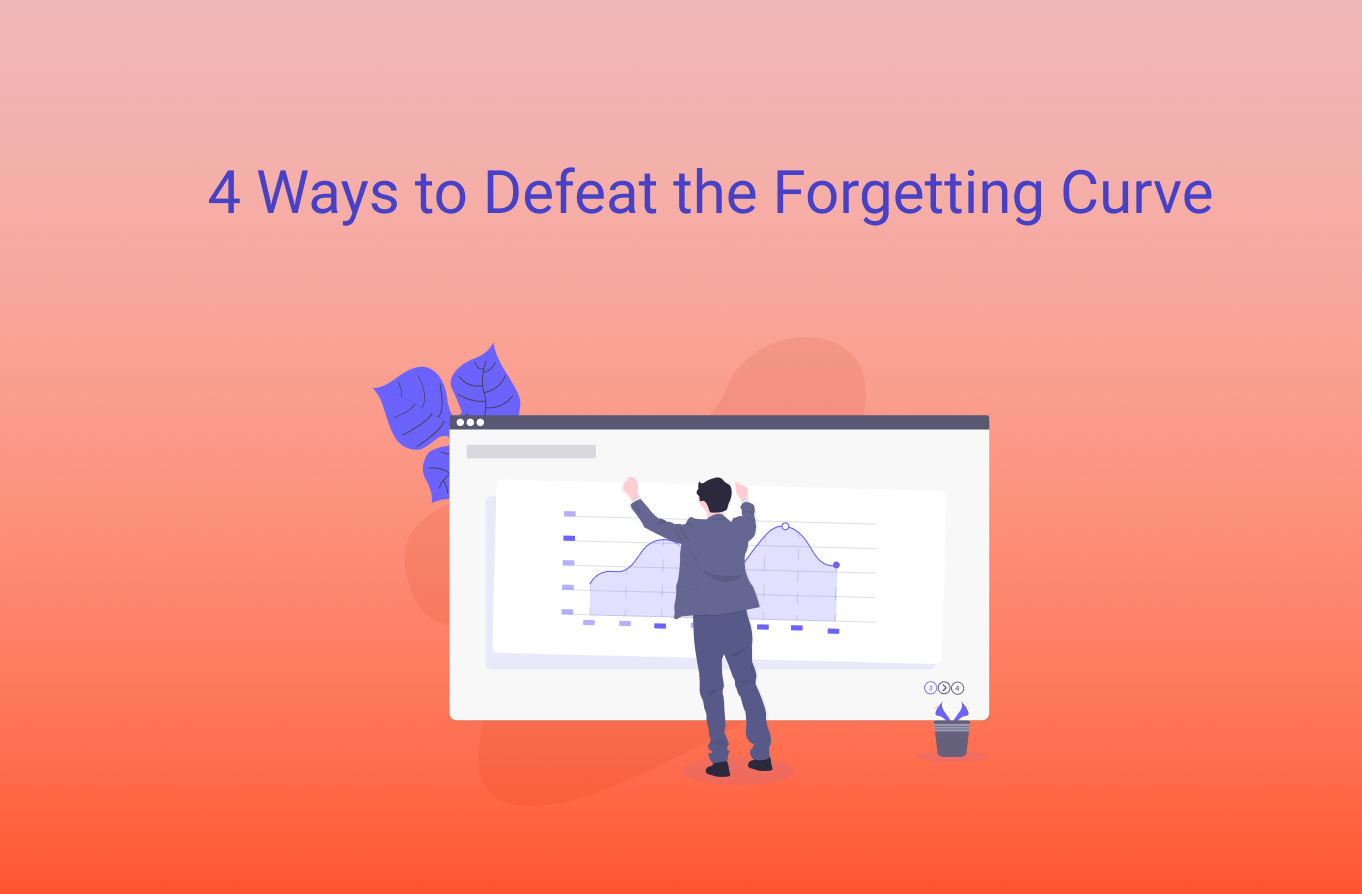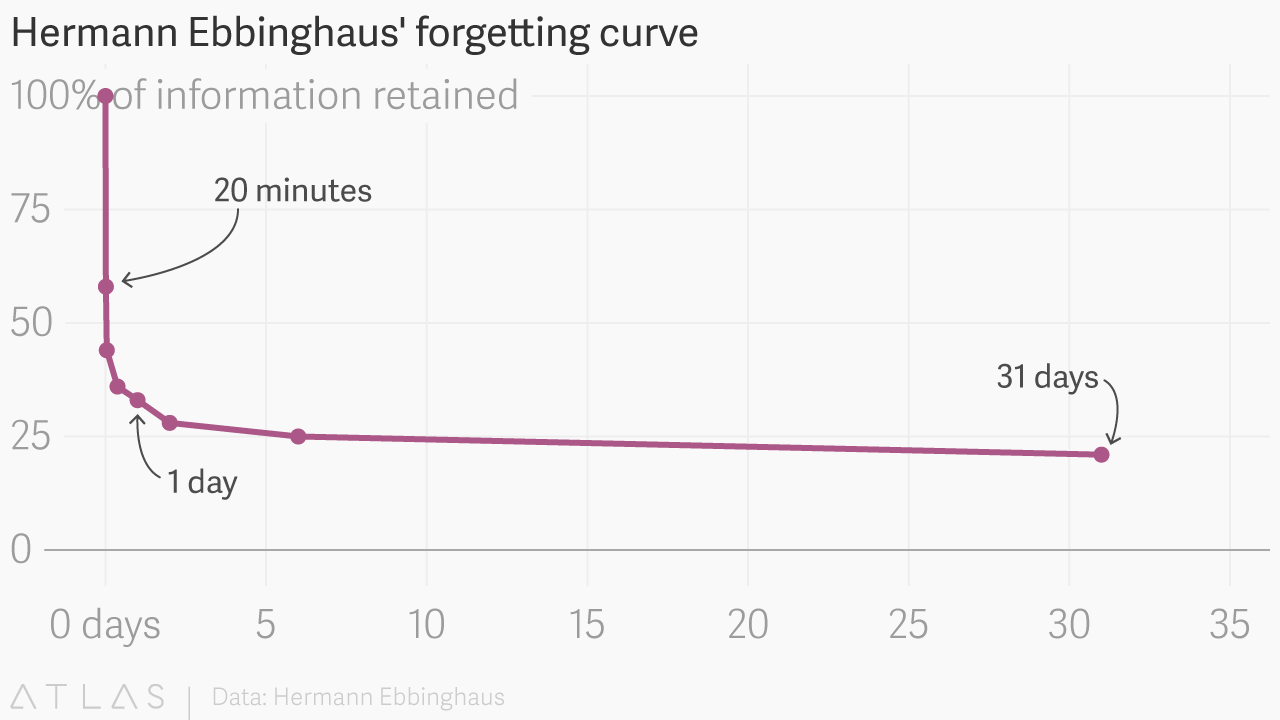Ways to Challenge the Forgetting Curve
6 minutes read

How often do your participants forget what they have learned during a training session? Probably very frequently. Usually, it is not possible for the human brain to remember every piece of information that it has consumed. This boils down to Ebbinghaus forgetting curve.
Ebbinghaus’ forgetting curve explains how easily we forget the information over time if we make no effort to retain it. This is obviously a challenging problem in the enterprise training and for L&D professionals.
Investing your time and money in training your employees is ineffective if they aren’t absorbing what they learn and applying it to their work.
Let us first explain the “forgetting curve” in more detail.
Ebbinghaus’ forgetting curve
Ebbinghaus’ forgetting curve is a mathematical formula that describes the rate at which something is forgotten after it is initially learned. This first originated in 1885 with a German psychologist Hermann Ebbinghaus.
Hermann Ebbinghaus was among the first scientists to perform experiments to understand how human memory works. He conducted a series of experiments on himself. This included memorizing a series of some meaningless three letter words like woz, dif, sen etc. Then, he tested himself periodically to see if he could retain that information after different time periods. Ebbinghaus discovered that his memory of them quickly decayed.
You probably are more familiar with this forgetting curve phenomenon than you think you are. Consider a scenario where you are about to launch a new product and you have trained all your employees about all the features of the product. Will they be able to remember all this new product information after a few days or weeks? Probably not.
Without regularly revisiting the concepts, they won’t retain much of what they have learned. Infact, some studies say that humans forget approximately 50% of new information within an hour of learning it. That goes up to an average of 70% within 24 hours.

The rate at which a human forgets information depends on a number of factors such as memory strength, how meaningful the material is, and physiological factors such as stress. But, the good news is that there are a number of methods to combat the forgetting curve and help your learners retain the crucial information. Let’s now look into each of those methods.

1. Spaced Learning
When we talk about retaining information for a long time, there are two important elements to consider. One is time and the other is repetition of information. This can be achieved using spaced learning, which is why it is considered to be an optimal method for combating the forgetting curve. Hermann Ebbinghaus discovered that the key to retaining crucial information is to repeat that information at regular intervals.
Basically, in spaced learning, the content to be learned is broken down into small chunks of information and is shared with the learners at regular intervals. Spaced learning can be tailored to suit your learning needs. The spacing can occur within a single course module, or by scheduling modules several hours, days, or weeks apart.
This kind of learning methodology effectively reinforces what has been learned as the learner studies information, and periodically returns to review it. It is also beneficial to organizations as it supports retention of skills and increased productivity in the long run.
2. Mobile Learning
If you want your training content to stick, you have to make its access convenient for your learners. Let’s say one of your sales reps is at a client meeting and the clients asks about a product feature. The sales rep needs a refresher on the information about this feature and she needs it now. In such a situation, there will be no time to get to a computer, sit down, turn it on, log in and comb through the entire training content to get to that information. Since fighting the forgetting curve is all about repetition, easy access to the learning content is paramount. This is where mobile learning come into play.
Ensure that your training content is accessible on mobile to make learning and retaining information easier for your learners. Learners can consume this information whenever and wherever they like - on the bus to work or while waiting for a client for a lunch meeting. This type of learning follows the psychology that training is most effective when learners actively seek out new information, instead of when the information is pushed on them.
3. Gamification
It’s always better to be proactive than reactive. While planning out your training content, make sure that it is interactive and engaging for your learners. Have a mix of various content types in your training like videos, images, and infographics. Additionally, if you want to efficiently beat the forgetting curve, gamification is the answer!
Gamification takes the mechanics of games and applies them to other activities, like training. So, gamification comes with the motivation elements like winning and rewards which motivate your learners to complete the required training. And, because it’s interactive and gets your learners engaged, knowledge retention is more likely.
Examples of gamification elements you could use in your training include badges, points, levels, and leaderboards.
4. Make it Relevant
The human brain is selective and has a limited capacity. When it comes to deciding whether to store particular pieces of information permanently, the brain can be quite choosy. And this naturally accelerates the forgetting curve.
That’s why it is important to make the training as relevant to the learner as possible. The more relevant the training, the easier it is to remember. Hence it is very important to customize the training according to the learner’s position and role. This will make the training much more meaningful for them.
So, how can you make your training content, relevant to your learner’s job role? You can use role filter so that the learners can only see the trainings that are relevant for them. You can include examples or scenarios that they experience every day in your training content. If you want learners to know new information or gain advanced skills, try to relate the training to information your learners already know.
With these 4 tips for combating the forgetting curve, you’ll be able to deliver effective training that will help your employees to absorb the information quickly and retain it for a long time.
Want to know about microlearning? Read the below articles:
Microlearning- An effective way to train millennials
How to Convert a PowerPoint Presentation into Microlearning Content?
Spaced Repetition and Microlearning: Two peas in a pod
Use Micro-Learning to Turbo-Charge your Sales Team
Looking for a sales training software that takes your sales training to a whole new level?
Explore SmartWinnr’s Learning and Gamification features. Learn how to run fun and engaging sales training and sales coaching for your team through SmartWinnr.
Curious to learn more about it? Book a demo today!
Published on Wed May 1 2019
